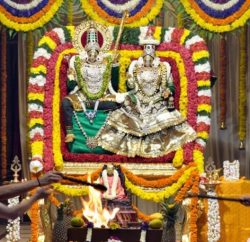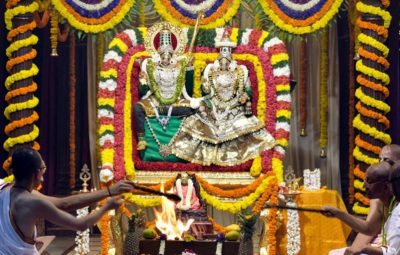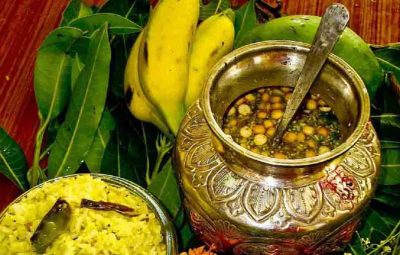The Kshira-chora Gopinatha temple is in Remuna, a small town located 9 km from the nearest railway station, Balasore, midway between Puri and Kolkata.
About six hundred years ago, the Deity of Gopinatha here had stolen a pot of sweet rice for Madhavendra Puri, a great Vaishnava sannyasi and the originator of the Madhva-Gaudiya-sampradaya. Therefore, the Lord here became very famous as Kshira-chora, the thief who stole the sweet rice.
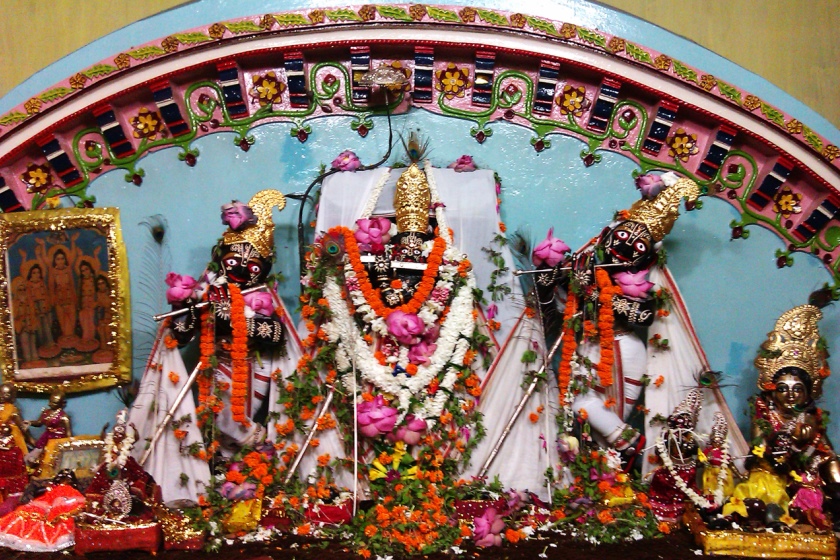
The Deities of Madana Mohana, Gopinatha and Govinda
To the right of Gopinatha is the Deity of Govinda and on the left, Madana-mohana. These two Deities were brought from Vrindavana in 1938. There are also Deities of Radha Rasabihari, Lord Jagannatha, Chaitanya Mahaprabhu and numerous salagrama shilas in the temple. It is said that Lord Rama carved the Deity of Gopinatha with His arrow and that Sita worshiped this Deity in Chitrakuta. King Langula Narasimha Deva of Utkal brought this Deity to Remuna in the 13th century from Chitrakuta, as instructed by the Lord in a dream and built a temple naming it Shri Gopinatha Mandir.
The present temple was renovated by Sri Rasikananda (a great devotee of Lord Krishna in the disciplic succession from Sri Chaitanya Mahaprabhu) after the original temple was destroyed by a Muslim invasion. He recovered the Deity of Gopinatha which had been hidden in a pond near the temple at that time.
Sri Chaitanya Mahaprabhu visited this temple while travelling to Puri. You can have darshan of His lotus foot prints next to the Garuda-stambha. There is also the samadhi of Sri Rasikananda within the temple precincts.
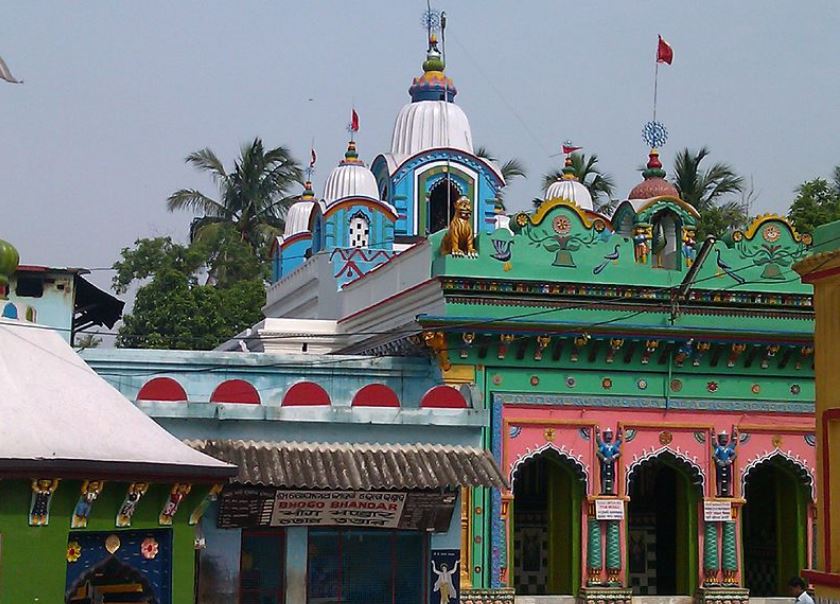
Kshira-chora Gopinatha Temple, Remuna
Over 500 years ago, Madhavendra Puri established a Deity of Gopala on top of the Govardhana Hill in Vrindavana. Once Gopala Deity appeared in a dream to Madhavendra Puri and asked him to bring sandalwood pulp and camphor from Jagannatha Puri and apply it on the body of the Deity. Madhavendra Puri started his journey and reached Remuna on his way to Puri. He visited the temple of Gopinatha and felt blissful to have darshan of the Lord. He then asked a priest about the food that they offer to the Deity. The priest told him about the special sweet rice, as tasty as nectar, which they prepare for the offering.
Meanwhile sweet rice was brought before the Deity to be offered to the Lord. Madhavendra Puri desired to taste it thinking that he would also prepare similar food in Vrindavana and offer it to the Deity of Gopala. Then he immediately realized his offence that he had desired to taste the food before it was offered to the Lord. Repenting for his unholy thought, Madhavendra Puri left the temple and went to a vacant place for chanting the holy names of the Lord.
On that night, the temple priest saw in a dream Lord Gopinatha who asked him to go to Madhavendra Puri and give him the pot of sweet rice which He had hidden under His garments. The priest got up, found the pot of sweet rice and went to Madhavendra Puri with the pot. Madhavendra Puri became overwhelmed with ecstasy to learn everything from the priest. After taking prasadam, he continued his journey and reached Puri from where he collected sandalwood and camphor.
On his way back, Madhavendra Puri again came to Remuna. There again he had a dream in which the Gopala Deity at Vrindavana told him to grind the sandalwood into pulp, mix with camphor and apply it on the body of Gopinatha Deity. Lord Gopala said that He was non-different from the Deity of Gopinatha. Madhavendra Puri made all arrangements to carry out the order of Lord Gopala.
This tradition is being followed in the temple even today. During Chandana-yatra celebrations, chandana (sandalwood pulp) is applied on the chest of Madana-mohana, Govinda and Gopinatha Deities. On the day of Akshaya Tritiya, the bodies of the Deities are covered entirely with chandana.
Here you can get delicious kshira prasadam (sweet rice), called Amruta Keli. It is a preparation of condensed milk, cream and sugar with a sprinkling of raisins.
To reach this place, you can travel to Balasore from Puri by train and then take a taxi/bus from the railway station to the temple.


